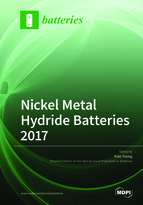Nickel Metal Hydride Batteries 2017
A special issue of Batteries (ISSN 2313-0105).
Deadline for manuscript submissions: closed (15 August 2017) | Viewed by 171773
Special Issue Editor
2. BASF Battery Materials-Ovonic, 2983 Waterview Drive, Rochester Hills, MI 48309, USA
Interests: metal hydride alloy; nickel/metal hydride battery; proton-conducting battery; solid-state battery; solid-state hydrogen storage
Special Issues, Collections and Topics in MDPI journals
Special Issue Information
Dear Colleagues,
MDPI has recently published a compilation of 20 papers summarizing the research efforts in improving the performance of nickel metal hydride (NiMH) batteries prior to 2016 in a single volume. To continue to serve the NiMH research community, we are planning to extend the effort to collect the NiMH-related papers in another coming volume—also a Special Issue of the same journal (Batteries). Papers of review, current research, and future planning in the materials, fabrication methods, cell integration and development, performance evaluation, failure analysis, market opportunities, and other subjects related to NiMH batteries are invited. Discussions and comments prior to manuscript submissions are also welcomed.
Dr. Kwo-Hsiung Young
Guest Editor
Manuscript Submission Information
Manuscripts should be submitted online at www.mdpi.com by registering and logging in to this website. Once you are registered, click here to go to the submission form. Manuscripts can be submitted until the deadline. All submissions that pass pre-check are peer-reviewed. Accepted papers will be published continuously in the journal (as soon as accepted) and will be listed together on the special issue website. Research articles, review articles as well as short communications are invited. For planned papers, a title and short abstract (about 100 words) can be sent to the Editorial Office for announcement on this website.
Submitted manuscripts should not have been published previously, nor be under consideration for publication elsewhere (except conference proceedings papers). All manuscripts are thoroughly refereed through a single-blind peer-review process. A guide for authors and other relevant information for submission of manuscripts is available on the Instructions for Authors page. Batteries is an international peer-reviewed open access monthly journal published by MDPI.
Please visit the Instructions for Authors page before submitting a manuscript. The Article Processing Charge (APC) for publication in this open access journal is 2700 CHF (Swiss Francs). Submitted papers should be well formatted and use good English. Authors may use MDPI's English editing service prior to publication or during author revisions.
Keywords
- NiMH battery
- electrochemical reaction
- battery performance evaluation
- hydrogen storage alloy
- nickel hydroxide






